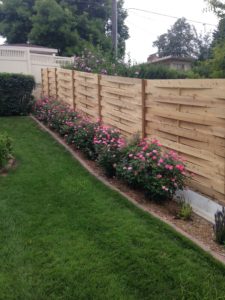We are your preferred custom wood fence provider
Custom wood fences are tricky. The tried and true solid, shadow box and picket wood fences use proven installation techniques that guarantee a long lasting installation. Most qualified fence contractors successfully install hundreds of these fences every year. Materials, fasteners and techniques are industry standards and there is a great deal of literature on “How to.” But what if you want something a little different or maybe a lot different?
When looking for a unique wood fence look or design; you are talking about a custom wood fence. This is the path less traveled in the fence industry and most contractors are not experienced in this type of installation. There is no industry standard or installation manual. You must rely on the contractors skills and resume.
Why are custom wood installations more of a challenge? Most custom wood installations involve using a dado cut that encapsulates the pickets, long horizontal cap boards or trim pieces, molding the edges with a crown, cove, round over or chamfered edge, or using a dado, rabbet, mortise or lap joint. All of these techniques involve not only the skill to perform the cut but also a complete understanding of how wood reacts over time.
When the lumber to build your wood fence arrives in your backyard, it all contains different levels of moisture. Some of it is kiln dried and some is not. Kiln drying lumber means the wood was placed in large ovens to remove excess moisture. When wood is kiln dried it also shrinks as the water evaporates. Lumber that is not kiln dried will shrink more over time than will kiln dried lumber. However, kiln dried lumber will tend to swell more under high humidity. Also, wood shrinkage and swelling will also depend on the type of wood species and where the wood was harvested from the tree from the center heartwood to the outer rings of the sapwood. You cannot stop wood from moving especially in outdoor installations. However, you can select installation techniques that take this movement into consideration.
Qualified and experienced fence contractors with a successful history of custom wood fence construction understand these installation techniques and how wood moves. They will use deep dado cuts that allow the wood piece to be installed in the cut to both expand and contract without bowing and slipping out of the cut respectively. They will use wood screws to secure long horizontal cap and trim pieces. Qualified wood fence builders will also carefully select their wood species in not combining materials that are on the opposite side of the spectrum like Oak which is least likely to move to Cedar is most likely to move. You would not want to use cedar rails with oak trim.
American Fence Company has been successfully building custom wood fences for over fifty years. We have hundreds of long standing installations throughout the Midwest. Our staff is experienced and relies on the collective wisdom of our corporation.
We have a one of a kind basket weave custom wood fence design that we have perfected over several years and installations. This design uses long deep dado cuts in the primary posts. We place a small 2” x 2” wood post in-between these primary posts. We then use long horizontal 1” x 6” x 8’ fir pickets. We like the fir as these are less likely to shrink. We force the horizontal picket into the dado cuts and bend it around the 2” square post. The picket is then screwed to the 2” posts but allowed to shrink and expand in the dado cut of the primary post. Because we bowed and forced the picket into the dado cut, the picket serves as a shock absorber when contracting and expanding so that it never shrinks and pulls out of the dado cut.
Where most fence contractors are not comfortable or experienced for this type of installation, American Fence Company looks forward to every installation as it is one of the most attractive fence styles and very unique.

